Often called pinks or Sweet William, Dianthus flowers belong to the Caryophyllaceae family, which includes carnations. There are over 300 species of Dianthus in the genus. They grow between 15 and 46 cm tall and are prized for their spicy cinnamon fragrance with clove notes. When shopping for Dianthus plants for the garden, it is easy to get confused because the genus includes annuals, perennials, and biennials. Let’s check out How to grow Dianthus in your garden below.
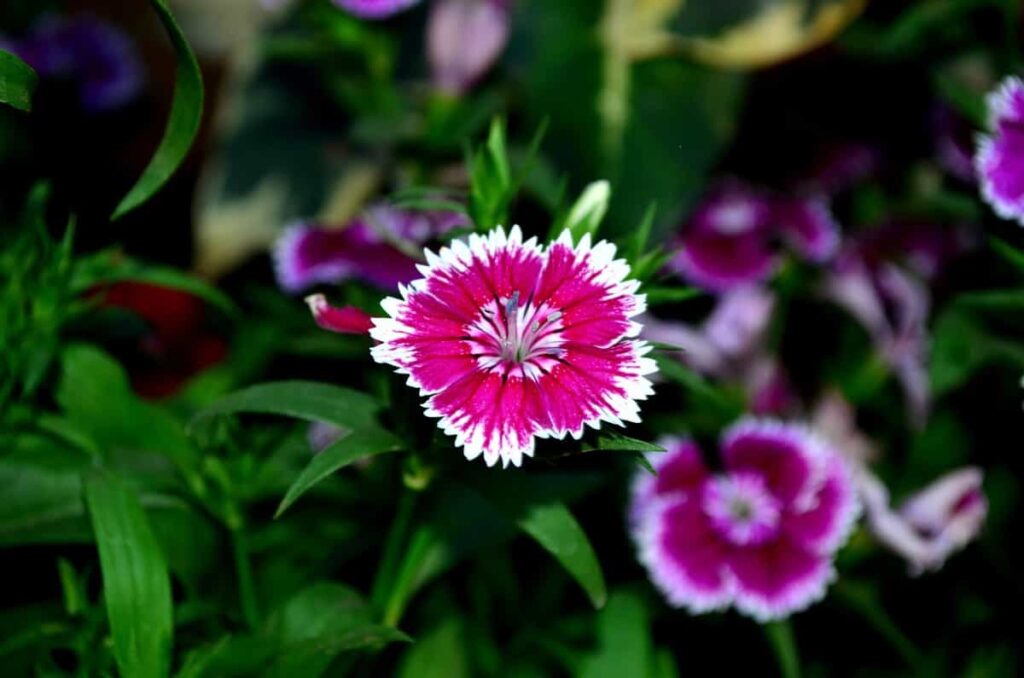
There is a specific time and place for each variety in a flower garden, but if you try to replicate grandma’s heirloom pinks, you will want to add the perennial Dianthus flower to your landscaping. A native of Europe, Asia, and Africa, Dianthus plants have handsome bluish-grey foliage that is stunning even when not blooming. The foliage, however, is narrow, even grass-like, and the plants may display a mounded shape, an upright habit, or a trailing habit.
It is important not to be confused by the name pink when choosing varieties of Dianthus for your landscape. Pink flowers are common in wide varieties, but this nickname is due to the fringed edges of the petals. Dianthus flowers are usually pink, red, salmon, and white, with thin leaves surrounded by thick stems. Growing these hardy plants all year round is possible if they are cared for properly.
The fastest-growing Dianthus plants are planted after all dangers of frost have passed in the spring. An emerging seedling can bloom within three months, and a mature plant can produce fruit within eight days. Generally, flowers bloom from late spring to fall, with some reblooming possible. All Dianthus blooms have jagged-edged petals, regardless of whether they are single or double. The Dianthus plant is poisonous to pets, unfortunately.
In case you missed it: India Flower Planting Calendar: Month-wise Garden Sowing Chart, Dates Guide for Winter, Summer, and Rainy Season
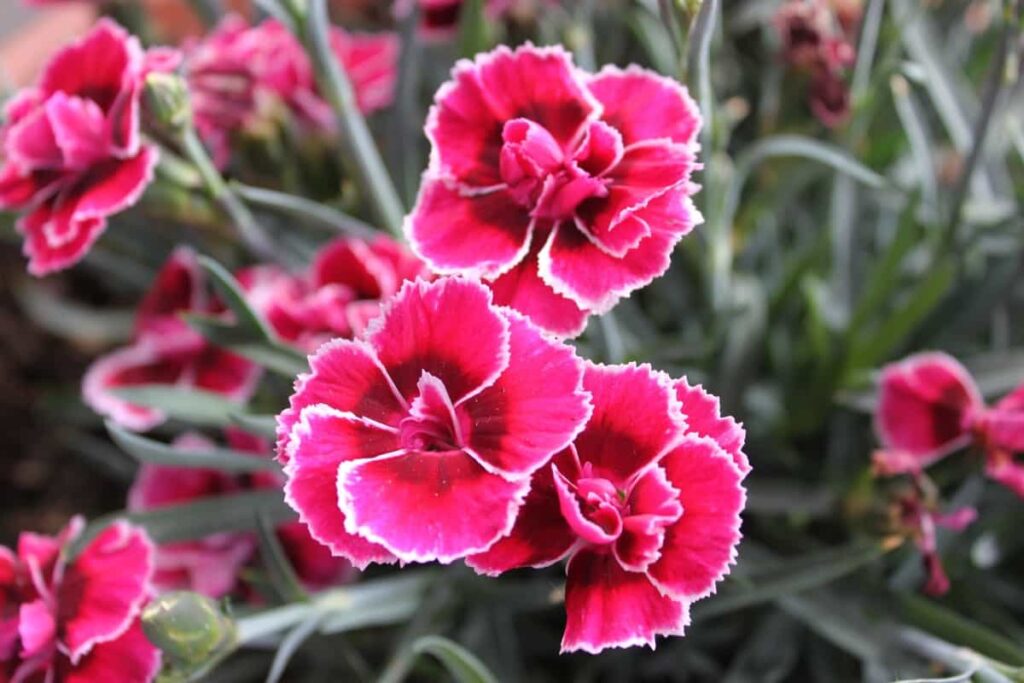
How to grow Dianthus in your garden
Types of Perennial Dianthus
There are several perennial Dianthus varieties with lovely colors and fragrant flowers. Some of the most common include:
Red Dwarf
The robust Red Dwarf is an excellent perennial for beds, borders, or containers with well-drained soil. Raspberry-pink flowers with deep crimson centers appear on this variety from late spring to early autumn. A maximum height of 7 inches is possible with this variety. This plant will require occasional maintenance and upkeep during the early spring before it begins active growth. Your yard will also attract bees and butterflies with this plant.
Arctic Fire
The evergreen perennial Dianthus deltoides Arctic Fire, also known as Maiden Pink, is vigorous and free-flowering. A profusion of white, single flowers adorned with delicately fringed petals and a brilliant red eye cover the foliage mound in late spring and summer. Bees and butterflies are attracted to the dainty blossoms, but deer ignore them. An excellent ground cover or edging for rock gardens, Maiden Pink is easy to grow. The plants can grow up to 6 to 8 inches tall and spread up to 12 to 18 inches wide.
Firewitch
Cheddar Pink, also known as Dianthus Firewitch, is an evergreen perennial with a strong clove fragrance that blooms in abundance with bright, purplish-pink flowers topped by frilled petals. They bloom in mid to late spring, covering the plant with blossoms in such quantities that they emerge from tufted mounds of grassy, blue-gray, silvery foliage. The plant will occasionally bloom in the summer and fall, particularly if it is deadheaded regularly.
This Cheddar Pink is an excellent choice for ground cover or rock garden plants due to its easy care and color. Regardless of the temperature or humidity, it does not have a problem. This eye-catching Cheddar Pink is quite hardy and sturdy and can reach a height of 6 to 8 inches and a spread of 6 to 12 inches.
In case you missed it: How to Make Rose Plants Bushy and Flowers Bigger: Propagation, Fertilizers, Pruning, Planting, and Care
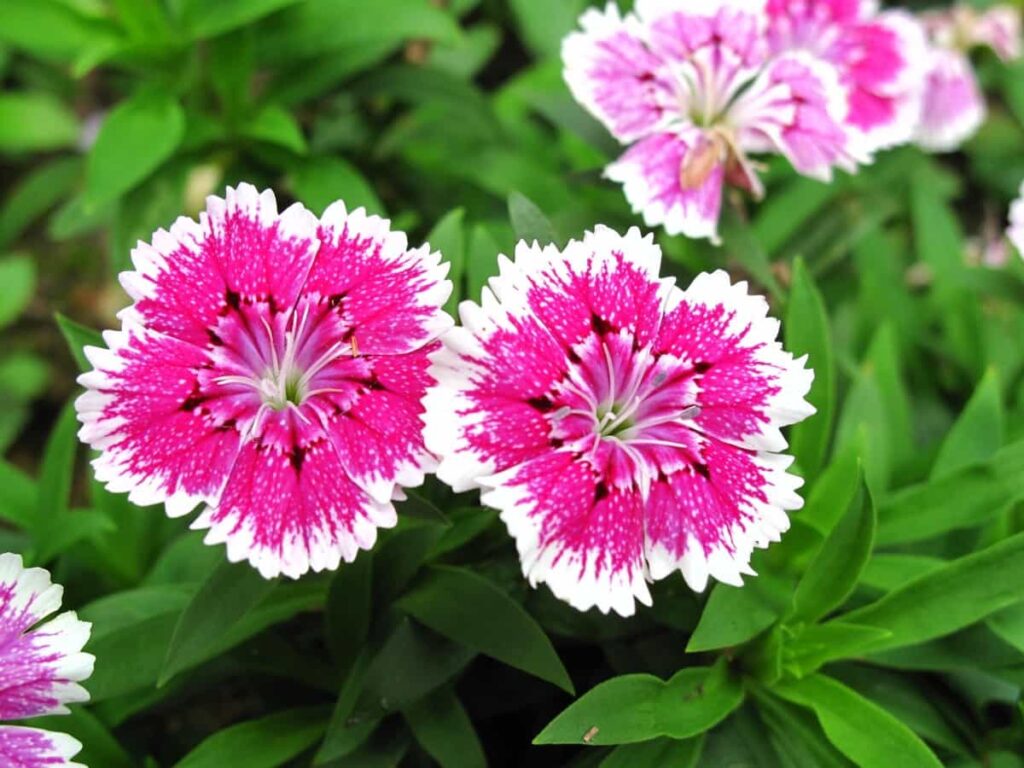
First Love
Dianthus First Love is a compact perennial with silvery blue-green foliage renowned for its changing colors of blossoms. During the late spring, through frost, the plant produces an abundance of white flowers that alter to pink and then mature to lavender color. These flowers having a sweet scent, attract butterflies and bees.
Except for the coldest winters, the foliage remains evergreen throughout the year. Plant this variety in the cottage garden or along the border to add a splash of color. Plants of this type of Dianthus grow from 12 to 18 inches tall and can spread up to 18 inches wide.
Rose de Mai
The ruffled blooms of the pink Rose de Mai have a spicy clove scent. You can plant this plant along border edges and in a well-drained rock garden to attract butterflies and bees. This variety is one of the earliest pinks to bloom in spring and continues to bloom for a long time. It produces copious quantities of fragrant, double flowers in a unique shade of lilac-pink with attractive blue-green foliage that reaches up to 15 inches in height.
For weed suppression, use fine gravel as a mulch. After summer blooms, shear the plant. Winter-killed stems can be pruned off in the spring. In early spring, divide the plants every two-three years to keep them vigorous.
Amur
The Amur River Pink, commonly known as the Amur Pink, is a hardy perennial Dianthus plant that can be easily grown from seed. Blooms of the Dianthus will begin in the middle of spring and continue until the first heavy frost in the fall. This pink-violet flowering plant has lance-shaped foliage that forms a lush mound with deep green leaves.
How to propagate and grow perennial Dianthus from cuttings
Dianthus plants can be propagated from seed or stem cuttings, ensuring that the new plants inherit the same as the mother plant characteristics. The following steps should be followed to propagate:
- A 2 to 3-inch cutting should be taken from a plant that has bloomed for at least a whole season. The best time to take cuttings is in June or July after the plants have finished blooming.
- Vermiculite and potting soil should be combined in a small pot, but the mixture should not be wet.
- The cutting should be dipped in a rooting hormone at the cut end.
- A minimum of one node must be below the soil line when planting the cutting into the potting soil.
- Make sure the pot is placed in a warm, sunny place.
- Moisture should be maintained in the soil. Then, within a month or two, the cutting should take root.
- In a few days, the cutting will have new leaf growth, so transplant it to its desired location and care for it as normal.
How to grow perennial Dianthus from seed
Plants such as Dianthus are easy to grow from seed, but the blooms they produce are not guaranteed to match the original. Plant seeds indoors around eight weeks before the last frost in your area if you plan to grow them from seed. It should take approximately eight to ten days for the seedlings to germinate in a warm, sunny location. Once the seedlings reach four inches tall, continue to grow them indoors. As soon as the risk of frost has passed, they can be planted outdoors.
Perennial Dianthus care
The majority of Dianthus flowers are easy to grow and can thrive in a variety of environments. Their blooms are best when they receive lots of sunlight, but they dislike the high temperatures of summer. It is possible to ensure a second bloom later in the summer or early in the fall by deadheading the plants after their first bloom. An excellent container garden plant, Dianthus plants bloom for a long time and have a mounding shape.
In case you missed it: How to Grow Potato Plants Faster: Best Tips to Increase Flowering, Fruiting, and Yield
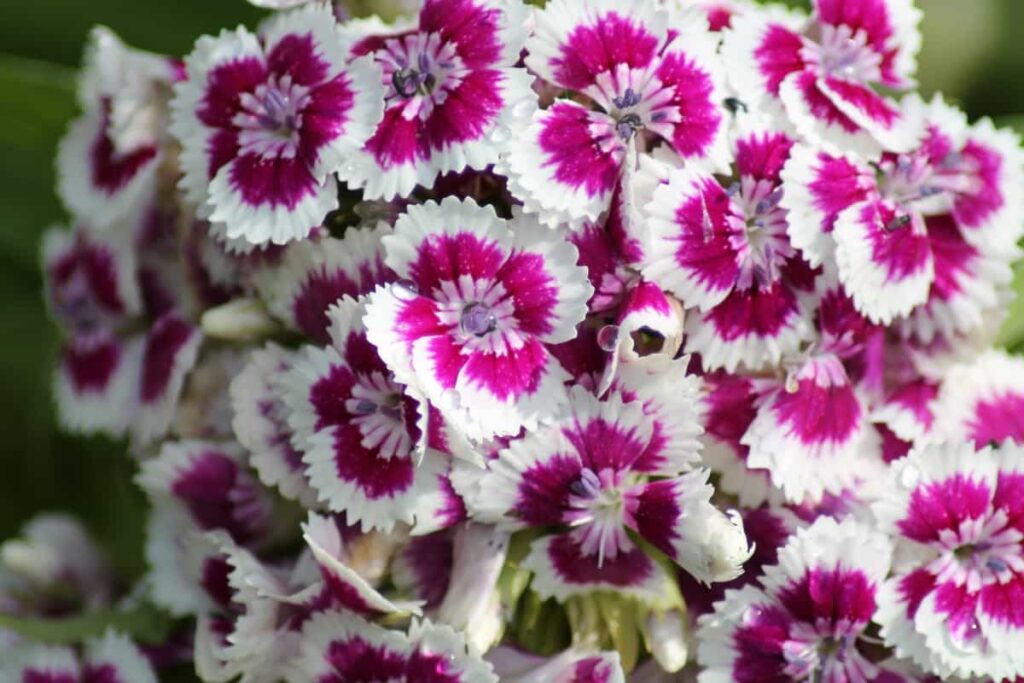
You can enjoy the pleasant clove fragrance of Dianthus in your garden beds by placing it near the front and borders. As Dianthus flowers have nectar that attracts both butterflies and hummingbirds, you can add them to a butterfly and hummingbird garden. You can also plant Dianthus in an alpine or rock garden, where they thrive in quick-draining soil. Dianthus plants are also resistant to deer but not rabbits.
How much and which type of sunlight is required for growing Dianthus
You should choose a location that receives at least six hours sunlight each day for thriving plants. Insufficient light can cause plants to produce fewer blooms or less vibrant flowers. Most go dormant in temperatures above 30°C, but some of these flowering plants continue to produce in hot weather.
Type of soil required for Dianthus
When the soil drains poorly, Dianthus plants can develop stem rot. Consider planting these plants in containers or raised beds if your garden soil is heavy clay. Dianthus plants also prefer a neutral to slightly alkaline soil pH. If your soil pH is below 7.0, add dolomitic limestone to correct the acidity. It is also possible to increase soil alkalinity with fireplace ashes. It is fine to use a mulch to control weeds, but avoid crowding the mulch around the crown of Dianthus to avoid rot.
How and when should water your Dianthus
Summer water twice a day, winter water once every two days, and if it rains, it’s best not to water. Never let a plant dry out. Make sure you do not pour water through pipes that could wash the plant/seed off. If you have a watering can, you can use it for watering. When the plant is growing, it needs regular watering. Water your plants one inch weekly, but do not let the soil become waterlogged.
Temperature and Humidity requirements for healthy growth of Dianthus
Light frosts are okay for these plants, but deep frosts are not. Plants should be covered with a frost blanket if temperatures drop below 4°C. Summer temperatures over 30°C will also cause the flowers to go dormant.
When and which fertilizer is used for Dianthus
If these plants are planted in the ground, you do not need to fertilize them. It is often sufficient to feed Dianthus with compost of good quality. The plants can be nourished by adding a shovelful of compost to the soil once a year. Light-balanced fertilizer is the only fertilizer you need to apply to your plants in the spring. Slow-release fertilizer products can be used for plants planted in containers or hanging baskets.
Pruning Perennial Dianthus
You can increase the chances of repeat bloom by regularly pruning your Dianthus plants. Deadhead flowers after they have spent their petals, especially varietals with repeated blooms. Make sure stems and leaves that appear diseased or damaged are removed throughout the year. In the fall, prune the plant until only one or two inches of stem remain above the soil. After going dormant for the season, the plant will grow the following spring again.
Common pests and plant diseases in Dianthus
Diseases
Wilt
The most common problem with Dianthus plants is vascular wilt. A fungus that can eventually kill an entire plant, wilt is characterized by dull green stems that droop and eventually dry out. The disease is difficult to treat since fungicides are ineffective, so you should rotate your plantings frequently and avoid planting in diseased soil.
Root and crown rots
Plants with root and crown rots display non-specific symptoms, including wilting, decline, and collapse of their foliage. Browning and rotting of the roots and crown are often associated with this droopiness or flaccid appearance, and yellowing and death of the outer leaves follow until the whole plant has died.
Infected plants are difficult to control once infected, so prevention is crucial. The plant should not be overwatered, especially in heavy soil, and it should not be watered directly into the crown area. Removing them is the best thing for highly symptomatic plants since they are unlikely to recover.
In case you missed it: How to Grow Okra Plants Faster: Best Tips to Increase Flowering, Fruiting, and Yield
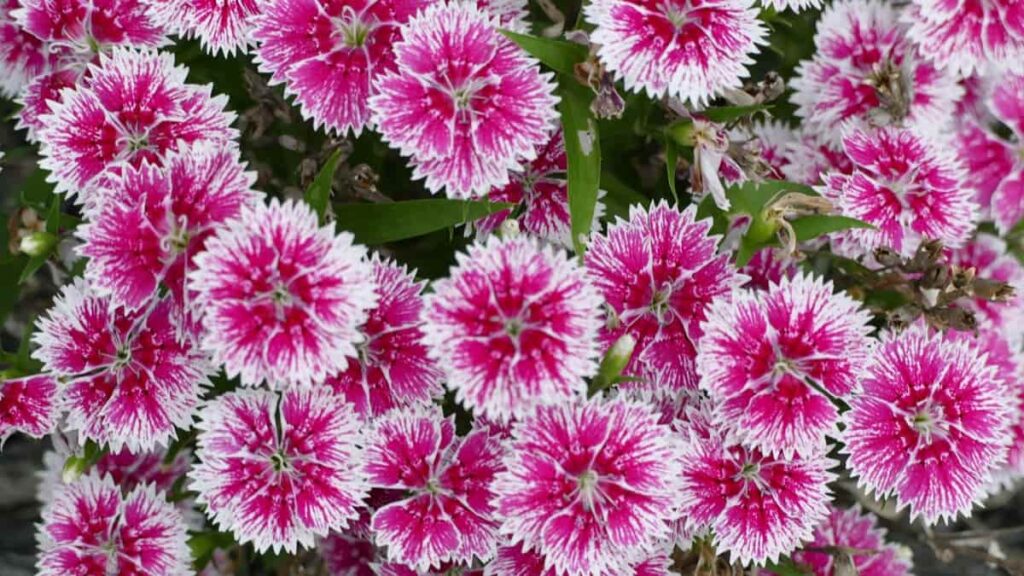
Leaf spots
Spots with pale tan to brown borders appear on the leaves. The colors, sizes, and numbers of these can vary. Fertilization and watering are important to maximize plant vigor. Watering should be done early in the day to give the foliage time to dry before nightfall. Symptomatic leaves should also be picked and removed as soon as they appear.
Rust
A chocolate-brown abscess develops on the leaves and stems of the plant. It is common for the leaves to turn brown when these ruptures occur. Plants infected with this virus may become stunted, and their leaves may curl. Plant refuse can be cleaned up in the fall, and plants should be adequately spaced to promote good air circulation to prevent this disease. It is possible to apply fungicides in the spring when new growth emerges, although it is rarely necessary.
Botrytis flower rot
The flowers become papery brown and covered in gray, fuzzy masses. Particularly susceptible are flowers in the process of senescence. It is also possible for leaves to develop brown or tan streaks. There is often a connection between these patches and the dropping of flowers on the leaf surface. Weather conditions that are cloudy, humid, and wet make this disease more problematic.
The potential for infection can be minimized by maintaining good sanitation practices, which include grooming the plants and removing spent or senescing flowers. Removing and discarding these affected tissues when they are dry is important. Furthermore, when watering plants and crowding them, it is important not to wet them. Maintaining an appropriate distance between plants is important to promote good air circulation. Symptoms can also be controlled with fungicide sprays applied as soon as they appear.
Pests in Dianthus:
| Pests | Symptoms | Control |
Aphids | The green peach aphid and the leaf curl plum aphid infest the young leaves and buds, suck the sap, and are often troublesome in greenhouses. | When needed, insecticidal soap and ultra-fine horticultural oil compounds control this pest. |
Spider mite | This pest infests the undersides of the leaves, which become light yellow, and the plants have a generally unhealthy appearance. | Insecticidal soap and ultrafine horticultural oil are used to control these pests |
Cutworms | Larvae of the variegated cutworm climb the stems, eat holes into carnation buds and feed on many other plants. | Use an insecticide spray for cutworms during the late afternoon or evening so that cutworms will be exposed to insecticide when they emerge in the evening. |
In case you missed it: Montana Vegetable Planting Calendar (MT): Month-wise Planting Chart, Schedule, and Guide for Zone 3, Zone 4, Zone 5, and Zone 6
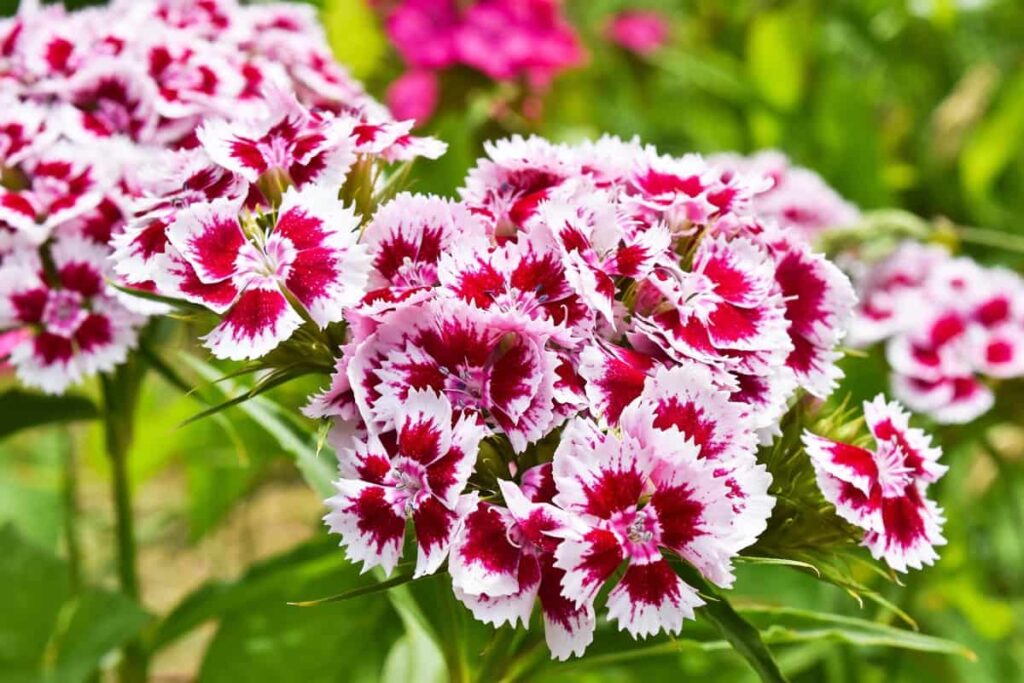
How to get perennial Dianthus to bloom
Many gardeners appreciate the easy care of Dianthus plants and that they rarely have trouble blooming. However, you should keep a few things in mind if you’re having trouble getting your plants to show off. The most important thing to remember is to place Dianthus plants somewhere that get at least six hours of direct sunlight daily. If the blooms are not given enough light, they will not be as frequent or vibrant as they should be.
Moreover, Dianthus plants need plenty of water for proper growth and blooming. Water the soil frequently every week to prevent it from drying out – you can also mulch around the roots of the plant to prevent moisture loss. It is also essential to groom Dianthus plants properly to encourage them to bloom. For example, it will make more buds and foliage if you deadhead the spent flowers frequently instead of letting the plant produce seeds from the spent blooms.
- Profitable Village Farming Business Ideas in 2024
- High-Yield Aquaculture: Fast-Growing Fish for Farming
- Effective Fish Pond Construction Techniques for Beginners
- Irrigation and Water Management in Pineapple Farming
- Blossom to Harvest: Mastering Flowering and Pollination in Papaya Farming
- Pig Fattening Essentials: From Selection to Sale for Beginners
- Raising Wagyu Cattle: A Complete Guide for Premium Beef Production
- Soil Types and Their Water Holding Capacity
- Optimizing Irrigation Schedules for Coconut Groves for Enhanced Yield
- Espresso Your Garden: Coffee Grounds for Healthier Acid-Loving Plants
- The Best Soil Mix for Snake Plants: How to Mix Your Own Snake Plant Soil
- Green Thumb Success: Expert Tips for Cultivating Greenhouse Beans All Year Round
- Bloom All Year Round: The Ultimate Guide to Indoor Hyacinth Care
- Eco-Friendly Gardening: How to Make Liquid Fertilizer from Kitchen Waste
- Ultimate Guide to Grow Anise in Pots: Explore Seed Propagation to Harvesting
- Guide to Raising Chester White Pigs: Discover Breed Facts to Growth Management
- Mastering the Elegance: The Ultimate Guide to Weeping Cherry Tree Care, Planting, and Maintenance
- Ultimate Guide to Planting Garlic in Grow Bags: Growing Strategies for Beginners
- How to Fix Spider Plant Leaf-Related Problems: Natural and Organic Remedies
- 10 Reasons Why Your Tulsi Plant is Shedding Leaves: Home Remedies and Solutions
- Optimizing Growth and Yield: The Advantages of Palm Bunch Ash Fertilizer
- Utilizing Neem Oil Extract as a Natural Pesticide for Hydrangea
- From Soil to Harvest: Various Ways in Which Farmers Can Use AI Tools
- Steps to Encourage and Induce Citrus Flowers: A Comprehensive Guide
- How to Fix Snake Plant Leaf-Related Issues: Natural and Organic Remedies
- Transform Your Garden into a Fragrant Oasis with Raat Ki Rani (Night Blooming Jasmine)
- Discover the Ideal Chicken Breeds for Philippine Farms
- How to Create a Poultry Egg Farm Business Plan for Profits
- Grow Lemon Cucumbers Like a Pro: Insider Techniques for Bountiful Yields
- Ultimate Guide to Caring for Your Pink Princess Philodendron: Tips for Thriving Variegation
- Areca Nut Profit Per Acre: Calculating Yield and Cost of Cultivation
- How Kaveri Chicken is Becoming a More Profitable Breed in Indian Backyards
- Transform Your Barn: 9 Steps to Convert a Horse Stall into a Chicken Coop
- Exploring Suffolk Sheep Disadvantages with Limitations and Challenges
- Guide to Solving Potted Lemon Tree Problems: How to Revive Lemon Tree in Containers
- Steps to Encourage Female Pumpkin Flowers: Best Strategies for More Flowers and High Yields
